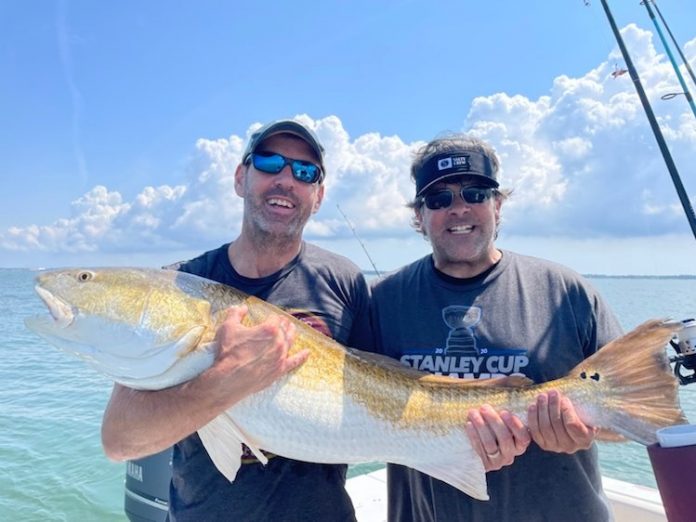
By Bill Hall –
High water temperatures and lower oxygen levels have combined to impact a lot of the local fishing activity negatively. Fishing early in the morning, especially during the latter portion of a rising tide, will often improve your odds of catching.
Spanish mackerel are one of the inshore exceptions, as the population increases as the water temperatures rise. Excellent Spanish mackerel action is being experienced in the lower Chesapeake Bay and schools of fish are now being targeted up into the Maryland-portion of the bay, as well as up to Assateague Island on the seaside.
Offshore action is also on the rise with the warmer water temperatures, with marlin, tuna, dolphin (mahi), and wahoo catches on the increase.
Northern Shore – Captain Matt Abell, at the Sea Hawk Sports Center, reported Spanish mackerel catches have come from the upper bay. Bayside sheepshead and a few black drum have been caught over areas of submerged structure, while schools of bluefish are abundant a little higher in the water column in the same areas. Recent early morning flood tides have produced some catches of speckled trout.
On the seaside, Captain Abell said flounder are being caught inside the inlets on silverside/Berkley Gulp combinations, while fish on the wrecks have been caught mainly on jigs. Triggerfish have been caught just above the wrecks, while cobia are cruising even higher in the water column. Spanish mackerel schools have now moved up the ocean as far north as Assateague. Offshore, most of the action has come from within the Washington Canyon, though one large king mackerel was boated inshore of the canyons.
Chincoteague – Jimmy Vasiliou, at Captain Steve’s Bait and Tackle, reported Wayne Miller landed a 245-pound bigeye tuna while chunking in the Washington Canyon. A trip on the following day produced a catch of 15 yellowfin. The offshore wrecks are producing good catches of black sea bass. Catches in the surf include lots of spot and kingfish (whiting) as well as a couple of red drum releases. Flounder catches are coming from inside of Chincoteague Bay, where numbers of croaker catches are on the increase. Larger flounder, including a couple of citation-sized fish, have been caught while jigging on the inshore wrecks, with catches of cobia coming from casting artificials over the wrecks. Ribbonfish were described as “everywhere.”
Wachapreague – Captain Lindsay Paul, of Trident Tackle, was fresh off a charter when he told me flounder fishing remains “pretty good” as long as you can find clear water conditions. Best fishing has occurred during the cooler water influx from a flood tide. Kingfish (whiting) and croakers are also showing up in the catches. Paul said reports from offshore have consisted of tuna and billfish in the canyons.
Amanda Manzella, at the Wachapreague Inn, reported flounder fishing is “still great” and that dolphin (mahi) catches were coming from the offshore waters.

Lower Shore – Dez Louie, at Oceans East –– Eastern Shore, said some cobia are still being caught by bottom fishing as well as sight casting, but he believes the bulk of the fish are in the process of spawning, as the fish have moved to deeper water and are not feeding. Louie believes cobia fishing will return after the spawning process has been completed. Sight casters have encountered some schools of red drum in between Fisherman Island and the third island of the Chesapeake Bay Bridge-Tunnel. Limits of Spanish mackerel are quickly being caught by anglers trolling Clark Spoons and casting Got-Cha Plugs to schools of surface feeding fish.
Flounder fishing has improved with keeper-sized fish coming from inside the Ditch, near the little bridge, and along the high rise. Spadefish continue to hit clam baits along the bridge-tunnel and over the Cell, while sheepshead catches are being made with crab baits along the bridge-tunnel pilings and around the concrete ships. Gray triggerfish catches have been a bycatch of the spadefish and sheepshead fisheries. The Kiptopeke State Park pier has produced catches of ribbonfish, croaker, spot, sand mullet (whiting), and rays.
Jeb Brady, at Bailey’s Bait & Tackle, described this week’s cobia fishing as “decent.” He said sight casting anglers reported that a large amount of fish were seen, but only a small portion showed any interests in responding to a bait. Most of the fish caught were in the 40- to 46-inch range. Bottom fishing for cobia was a little slower and the size averaged a little smaller with a good portion in the 30- to 40-inch range. Spadefishing was described as “real good,” especially around the fourth island, Plantation Light, and the Cell. Spanish mackerel action continues to improve, especially in the waters between Kiptopeke and Cape Charles. Brady said the best flounder action was coming from inside the Ditch. Sand mullet (whiting) catch numbers have been high in the cabbage patch and along the concrete ships. Ribbonfish, small gray trout, and spot catches have come from the Cape Charles Pier.
Bill Hall was the first Eastern Shore resident to achieve Virginia Salt Water Master Angler Status. He has been named Virginia Saltwater Angler of the Year and Virginia Saltwater Release Angler of the Year and is a Virginia Press Association award-winning sports columnist.


